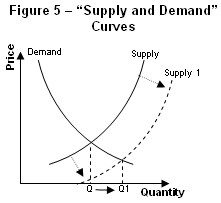Supply and demand




Supply and demand are fundamental concepts in the field of economics that describe how the market determines the price and quantity of goods and services. The theory of supply and demand is central to understanding how markets operate and is a foundational principle in microeconomics.
Overview[edit]
At its core, the concept of supply and demand involves the interaction between the availability of a product or service (supply) and the desire of potential buyers for it (demand). The price of the good or service is determined by this interaction, with higher demand and lower supply typically leading to higher prices, and vice versa.
Supply[edit]
In economic terms, supply refers to the total amount of a specific good or service that is available to consumers. Supply can be influenced by several factors, including the cost of production, technological advancements, and the number of suppliers in the market. Suppliers are more willing to offer more of a good or service as its price increases, all else being equal, which is described by the law of supply.
Demand[edit]
Demand, on the other hand, represents the quantity of a good or service that consumers are willing and able to purchase at various prices. The main factors affecting demand include the price of the good or service, consumers' income levels, tastes and preferences, and the prices of related goods (substitutes and complements). According to the law of demand, there is an inverse relationship between the price of a good and the quantity demanded, meaning consumers will buy more of a good as its price decreases.
Equilibrium[edit]
The point at which the quantity of a good or service supplied equals the quantity demanded is known as the market equilibrium. At this point, the market price stabilizes, assuming no external influences affect the market. If the market price is above the equilibrium price, a surplus occurs, leading suppliers to lower prices to sell the excess supply. Conversely, if the market price is below the equilibrium price, a shortage occurs, leading to an increase in prices as consumers compete for the limited supply.
Shifts in Supply and Demand[edit]
Supply and demand curves can shift due to various factors, leading to changes in the equilibrium price and quantity. Factors that can shift the demand curve include changes in consumer preferences, income levels, and prices of related goods. Supply curve shifts can result from changes in production costs, technological advancements, and the number of suppliers.
Applications[edit]
The principles of supply and demand are applied across various sectors of the economy to analyze market dynamics, including labor markets, commodity markets, and financial markets. Understanding these principles helps economists, policymakers, and businesses make informed decisions.
Conclusion[edit]
Supply and demand are crucial for determining the prices and quantities of goods and services in a market economy. By analyzing the factors that affect supply and demand, stakeholders can better predict how changes in the market will affect these variables.
Ad. Transform your life with W8MD's Budget GLP-1 injections from $75


W8MD offers a medical weight loss program to lose weight in Philadelphia. Our physician-supervised medical weight loss provides:
- Weight loss injections in NYC (generic and brand names):
- Zepbound / Mounjaro, Wegovy / Ozempic, Saxenda
- Most insurances accepted or discounted self-pay rates. We will obtain insurance prior authorizations if needed.
- Generic GLP1 weight loss injections from $75 for the starting dose.
- Also offer prescription weight loss medications including Phentermine, Qsymia, Diethylpropion, Contrave etc.
NYC weight loss doctor appointmentsNYC weight loss doctor appointments
Start your NYC weight loss journey today at our NYC medical weight loss and Philadelphia medical weight loss clinics.
- Call 718-946-5500 to lose weight in NYC or for medical weight loss in Philadelphia 215-676-2334.
- Tags:NYC medical weight loss, Philadelphia lose weight Zepbound NYC, Budget GLP1 weight loss injections, Wegovy Philadelphia, Wegovy NYC, Philadelphia medical weight loss, Brookly weight loss and Wegovy NYC
|
WikiMD's Wellness Encyclopedia |
| Let Food Be Thy Medicine Medicine Thy Food - Hippocrates |
Medical Disclaimer: WikiMD is not a substitute for professional medical advice. The information on WikiMD is provided as an information resource only, may be incorrect, outdated or misleading, and is not to be used or relied on for any diagnostic or treatment purposes. Please consult your health care provider before making any healthcare decisions or for guidance about a specific medical condition. WikiMD expressly disclaims responsibility, and shall have no liability, for any damages, loss, injury, or liability whatsoever suffered as a result of your reliance on the information contained in this site. By visiting this site you agree to the foregoing terms and conditions, which may from time to time be changed or supplemented by WikiMD. If you do not agree to the foregoing terms and conditions, you should not enter or use this site. See full disclaimer.
Credits:Most images are courtesy of Wikimedia commons, and templates, categories Wikipedia, licensed under CC BY SA or similar.
Translate this page: - East Asian
中文,
日本,
한국어,
South Asian
हिन्दी,
தமிழ்,
తెలుగు,
Urdu,
ಕನ್ನಡ,
Southeast Asian
Indonesian,
Vietnamese,
Thai,
မြန်မာဘာသာ,
বাংলা
European
español,
Deutsch,
français,
Greek,
português do Brasil,
polski,
română,
русский,
Nederlands,
norsk,
svenska,
suomi,
Italian
Middle Eastern & African
عربى,
Turkish,
Persian,
Hebrew,
Afrikaans,
isiZulu,
Kiswahili,
Other
Bulgarian,
Hungarian,
Czech,
Swedish,
മലയാളം,
मराठी,
ਪੰਜਾਬੀ,
ગુજરાતી,
Portuguese,
Ukrainian
